The consumer price index (CPI) rose 3.5% year-on-year in August 2010, the highest level since October 2008. However, inflationary pressure appears to be weakening with the slowing of the economy and growth in money supply. As a result, the possibility of a rate hike is receding.
Inflation reaching the turning point
In China, inflation has shown a historical tendency to lag behind economic growth by about three quarters. More specifically, regression analysis for the period from the first quarter of 1998 and the second quarter of 2010 shows that if the growth rate for the current quarter rises (falls) one percentage point, the inflation rate will rise (fall) one percentage point three quarters later. Given that the current business cycle peaked in the first quarter of 2010 (with GDP growing 11.9% year-on-year), then based on past patterns, the inflation rate should peak in the fourth quarter of 2010 and fall after that (Figure 1).
| Figure 1: Inflation Lagging Behind GDP Growth | |
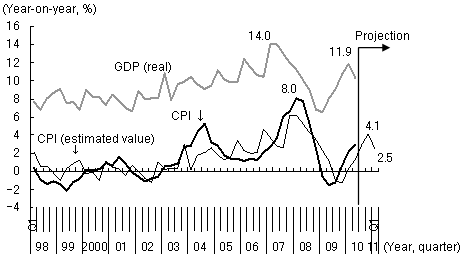 | |
| (Note) | Estimated values of CPI are based on regression analysis. Estimation period: The first quarter (Q1) of 1998 to the second quarter (Q2) of 2010 |
| (Source) | Based on data of the National Bureau of Statistics of China |
However, inflation is actually now more likely to reach a turning point as early as the third quarter, for the following reasons.
First, the effects of monetary tightening have begun to emerge. The quantitative ceilings on bank lending, which were eased substantially in the wake of the collapse of Lehman Brothers, were tightened once again in the spring of 2009. This was followed by three hikes in bank reserve requirements totaling 1.5 points that started in early 2010. Subsequently, the growth in money supply (M2) slowed to 19.2% in August 2010, down from a peak of 29.7% in November 2009, and this has eased inflationary pressure (Figure 2).
| Figure 2: Weakening Inflationary Pressure Due to Slower Growth of Money Supply | |
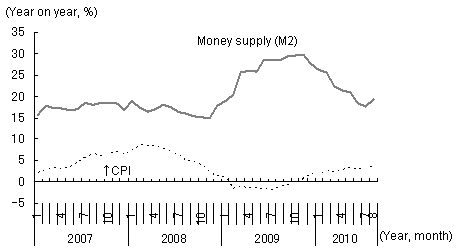 | |
| (Source) | The National Bureau of Statistics of China |
Also, the year-on-year rate of increase in the producer price index (PPI), a leading indicator of CPI, has slowed down after peaking in May 2010. In particular, prices of mining products, raw materials, and the processing industry in the upstream of the supply chain peaked in February, May, and June, respectively. This trend will encompass consumer goods downstream before long (Figure 3).
| Figure 3: PPI Implying Weakening Inflationary Pressure | |
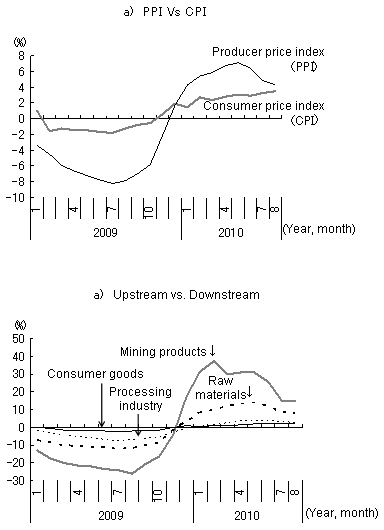 | |
| (Note) | The PPI is for producer goods upstream and consumer goods downstream, and the former consists of three sectors: mining products, raw materials and the processing industry. |
| (Source) | The National Bureau of Statistics of China |
The average inflation rate from January to August 2010 is 2.8%, and the inflation rate from September to December is expected to be lower than 3.5%, the actual inflation rate in August. Therefore, the government is likely to achieve its annual target of 3% or less.
Can a rate hike be avoided?
As nominal interest rates have been left unchanged at their current low level since December 2008, following a series of rate cuts after the collapse Lehman Brothers, rising inflation has caused a fall in real interest rates. The real lending rate, obtained by subtracting the year-on-year rate of increase in CPI from the one-year lending rate, has fallen sharply from its peak of 7.11% in July 2009, to 1.81% (5.31%-3.5%) in August 2010. As the fall in the real lending rate is one factor pushing up real estate prices, there is a strong feeling that a rate hike is needed to rein in the real estate bubble. Also, the real deposit rate, based on the interest rate on one-year time deposits (2.25%), has been negative since February 2010 and was -1.25% as of August (Figure 4). This means that the real purchasing power of deposits has declined as much as 1.25% on an annualized basis, even when interest earned is taken into consideration, and that depositors are suffering accordingly. With this as the backdrop, depositors are calling for the rate hike.
| Figure 4: Real Interest Rate Turning Negative with Higher Inflation | |
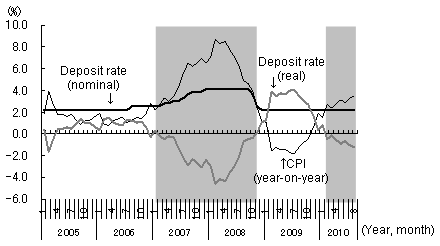 | |
| (Note) | Shaded areas indicate the periods when the real deposit rate turned negative. The deposit rate refers to the one-year time deposit rate. Deposit rate (real) = Deposit rate (nominal) - CPI (year-on-year) |
| (Source) | The National Bureau of Statistics of China and the People's Bank of China |
However, there are many arguments against a rate hike.
First, since the rise in inflation is entering its final phase following the slowdown of the economy, real interest rates are expected to begin climbing soon in the form of falling inflation, even without a rate hike. Indeed, a rate hike now could put the economy at risk of stalling.
Second, the ongoing inflation is largely attributable to rises in food prices that are susceptible to weather and hard to control with rate hikes (Figure 5). In fact, 2.5 percentage points of the 3.5% year-on-year rate of increase in CPI in August 2010 is attributable to food price inflation.
| Figure 5: Rises in Food Prices Making a Large Contribution to Inflation | |
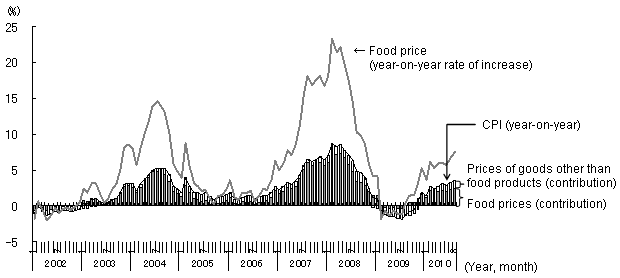 | |
| (Source) | The National Bureau of Statistics of China |
Third, the need to hold down real estate prices with a rate hike is receding. Real estate prices have now entered a correction phase, thanks to measures centering on the limitation of mortgage loans introduced in April 2010. The year-on-year rate of increase in housing prices in 70 large and medium cities has been falling from its peak of 12.8% in April to 9.3% in August, and housing prices have almost stalled since May on a month-on-month basis.
Fourth, the external environment facing China also constrains its ability to increase rates freely. The global economy is not yet completely free of fears of a double dip recession, and so developed countries have been slow to end their ultra-easy monetary policy (implementing the so-called exit strategy). If China leads the way with an interest rate hike in these circumstances, the widened differential between domestic and foreign interest rates could provoke an inflow of capital from overseas. This could in turn dilute the tightening effect associated with the rate hike.
Finally, although some have called for an asymmetric rate hike (raising only deposit rates while leaving lending rates unchanged) to alleviate the discontent of savers while, at the same time minimizing the adverse effect on the economy, banks are objecting to this because it would reduce their profits by narrowing the interest rate spread.
Making an overall judgment in light of these domestic and external economic conditions, a rate hike looks unlikely in the foreseeable future. If it is confirmed that the inflation rate in September (to be announced in mid-October) is lower than it was in August, fears of a rate hike will recede further.


